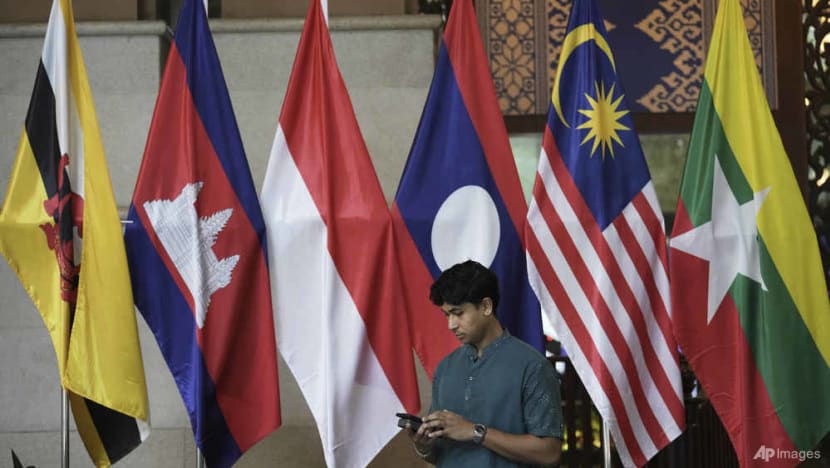Commentary: ASEAN isn’t retaliating on US tariffs. That doesn’t mean it’s not responding
In a peaceful and globalised world, ASEAN integration is a good-to-have. But in a conflictual and autarkic world, it becomes a necessity, says political analyst James Chai.


This audio is generated by an AI tool.
KUALA LUMPUR: In his inaugural address on Jan 20, United States President Trump declared that he would “immediately begin the overhaul of (its) trade system”, and “tariff and tax foreign countries to enrich (its) citizens”.
He first took aim at Canada and Mexico, then trained his guns on his chief adversary: China, starting at 10 per cent tariffs, then doubling to 20 per cent a month later. As expected, China retaliated and declared that it “won’t be bullied”.
Fast forward to April and several rounds of tit-for-tat action with matching dizziness in the stock markets, US tariffs on Chinese imports have surged to 125 per cent, while China’s tariffs on American goods are at 84 per cent.
Until recently, Mr Trump barely mentioned Southeast Asia - and that was how the 700-million people region preferred it. Trained in decades-long hedging tactics between major powers, Southeast Asians knew how to be quiet and stay in the shadows. When elephants fight, small animals want to avoid getting hurt.
Then came Mr Trump’s “Liberation Day” and no one was spared. The US reciprocal tariffs hit almost everyone in the animal kingdom - friends (Australia, United Kingdom, Japan, Korea, European Union), foes (China, Syria), middle powers (Association of Southeast Asian Nations, Brazil, Turkey, South Africa), and the smallest states (Lesotho, Madagascar, Nauru, Falkland Islands, Norfolk Island).
Panic phone calls, negotiation requests, and strongly worded press statements followed, but they could not escape the truth: That this was a fundamental reordering of the global trade system.
ASEAN OPTS FOR DIALOGUE OVER RETALIATION
ASEAN ministers first pursued negotiation forums with the Trump administration as individual countries. But on Thursday (Apr 10), ASEAN ministers gathered to formulate a collective response to the tariffs, which was a marked change of institutional behaviour.
This meeting was particularly significant as it came just hours after Mr Trump’s announcement of a temporary 90-day pause to the tariffs. It shows that ASEAN is starting to recognise the value of integration that is more long-term than a circumstantial response to one event.
It also provides an affirmation of ASEAN’s core strategy in global power conflict. In a joint statement, the 10-nation group declared that it will not retaliate.
“Open communication and collaboration will be crucial to ensuring a balanced and sustainable relationship,” the statement read.
While it is understandable that ASEAN still lacked the economic weight to retaliate on its own, it should not be taken as passivity or subjugation to the predicament. It is, in fact, a classic hedging strategy.
The ISEAS-Yusof Ishak Institute’s latest annual State of Southeast Asia Survey Report provides clues to how Southeast Asians think about themselves and the world. While the survey was completed before Mr Trump’s Liberation Day tariffs, it sheds light on their leanings.
PRAGMATISM TAKES PRECEDENCE
Tellingly, many worry that ASEAN risks becoming an “arena of major power competition” and its members may become “major power proxies”. The reciprocal tariffs started as a trade war between the US and China, but then quickly affected others that simply met the “trade deficit” narrative, especially emerging economies like ASEAN.
As a result of the highly aggressive tariffs - a universal baseline of 10 per cent for all including trade surplus countries like Singapore, and additional rates somewhat-proportional to the trade imbalances - analysts have put recession risks above 60 per cent. Many economists are anticipating higher inflation, unemployment and inequality as add-ons.
Unsurprisingly, the reciprocal tariffs will likely heighten Southeast Asia’s distrust in the US, potentially opening room for other major powers to replace. Even before Liberation Day, 46.9 per cent of the ISEAS survey respondents identified “new US leadership” (ie, Mr Trump) as a chief geopolitical concern, up from 18.8 per cent in 2024, which cited the “2024 US presidential elections” as a concern.
In the last two years, Southeast Asians have shifted back and forth between the US and China relating to strategic alignment and confidence in them on global free trade.
Most Southeast Asians aligned with China in 2024, but this was replaced by the US this year (52.3 per cent vs China’s 47.7 per cent). Southeast Asians had the most confidence in the US on the global free trade agenda in 2024, but this shifted to China in 2025 (20.6 per cent vs US’ 19 per cent).
What this shows is that Southeast Asia has become more flexible in which major power they prefer, driven by pragmatism than loyalty.
Interestingly, Indonesia, Malaysia, and Singapore were the only ASEAN countries where distrust for the US exceeded trust. These three countries also happen to have the highest perceived contribution to ASEAN, potentially guiding an ASEAN consensus.
ASEAN INTEGRATION
To manage the risks of Mr Trump’s tariffs and the economic uncertainty, the best solution for ASEAN is diversification - both in trade and alignment.
In response to rising protectionism and nationalism, there is a growing consensus among ASEAN member states that deeper regional integration is the most viable path forward. This likely involves increasing trade and investment links between member states, building on respective comparative advantages, to increase regional self-sufficiency on strategic goods and services.
While such partnerships are already in motion, the Liberation Day tariffs serve as a timely reminder that without collective strength to bargain, the region of middle powers will only be takers. That is why, despite frustrations with the tariffs, most ASEAN powers could not retaliate, simply due to the lack of economic weight and high trade dependency.
The radically changing trade landscape has also given ASEAN renewed confidence in leading the global free trade agenda. Decades of free trade has uplifted ASEAN out of poverty, built manufacturing bases, and developed talent profiles that are globally competitive. Now they have more confidence in carrying this out as leaders, than simply waiting on the major powers.
Another strategy is to trade more with other major economic blocs, to diversify and hedge against the two major powers. On this, Southeast Asians take a practical viewpoint of leaning towards large-scale economies with political capital - the EU and Japan coming at the top.
In the ISEAS survey, around 51.9 per cent believed that the EU will “do the right thing” for global peace, security, prosperity and governance. Amidst the trade war, the EU has shown a balance of strength (tariff retaliation against US and tariff on China) and openness to negotiate (free trade agreement with several ASEAN countries). The same is true for Japan, where Southeast Asians have the highest trust in them.
While ASEAN will continue to engage in dialogue with the US, they will also seek alternative trading arrangements with other blocs. At the back of their minds, they are not just looking to sign more agreements, but to seek partners who are ideologically committed to the notion of free trade.
Although long anticipated, the US tariffs and other trade disruptions will still be shocks for ASEAN to absorb. Diversification strategies will take time, especially for ASEAN, where most Southeast Asian nations admittedly have been inefficient and fragmented in the past.
In a peaceful, globalised, and intertwined world, ASEAN integration is a good-to-have. But in a conflictual, protectionist, and autarkic world, it becomes a necessity.
James Chai is a political analyst, columnist and the author of Sang Kancil (Penguin Random House).














.jpg?itok=eCp5s7-3)






